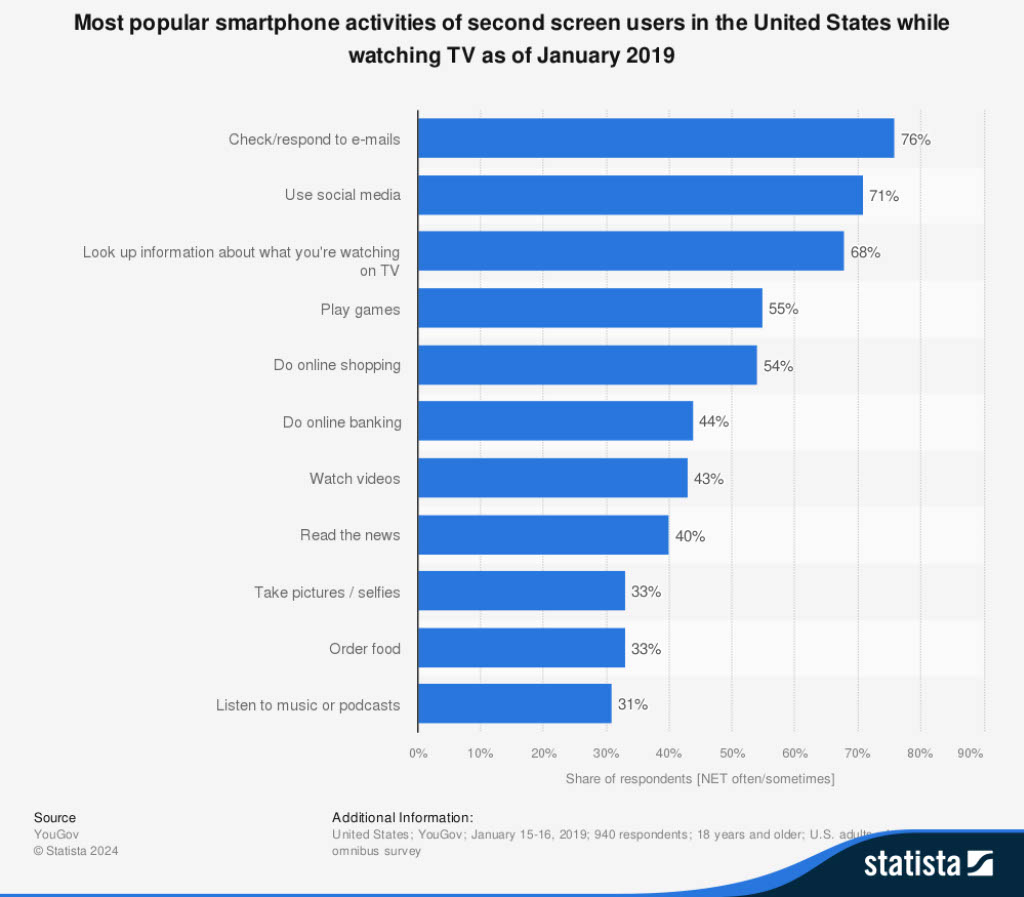Have you ever scrolled through social media on your phone while you watch TV? What about listening to a podcast while monitoring your work email on your laptop? Many of us are guilty of parsing our attention across many devices at any given time—so many of us, in fact, that this phenomenon has a name: second screen media.
The “first screen” that precedes the second screen is almost always assumed to be television, although, in an increasingly mobile world, that may or may not be the case. In general, the first screen is where you’re engaging with the content you initially intended to watch, and the second screen is for whatever else you’re doing at the same time.
With that in mind, let’s take a look at how second screen media came to be and what it means for today’s advertisers.
How Did Second Screen Media Come About?
There are a few explanations for the evolution of second screen media. The first is the most obvious: Our attention spans are getting shorter, and staying engaged with long-form content is becoming increasingly difficult.
Another explanation skews more positive. It captures the fact that having a wealth of information at our fingertips means that some consumers are actively seeking more information about the content they’re watching. If you’ve ever Googled the celebrity whose name you can’t quite place while you’re watching a new Netflix show, you’ve fallen into this category.
Some consumers may also react to what they’re seeing on television, and then share their reactions or search for more information in real-time. If you’ve ever live-Tweeted a particularly interesting TV episode, you’ve contributed to this statistic. Whether you consciously recognize it or not, you are engaging with the content in front of you in a way that transcends the TV screen (or the tablet/laptop/smartphone screen, as the case may be).
Last but not least, multitasking, in an “always-on,” hustle-based culture, is another explanation for the double screen. Many people today (especially younger generations) don’t feel like it’s acceptable to sit and watch TV just for the sake of watching TV. That time has to also be used for catching up on emails, reading news, sending texts, or even “leisure” multitasking like scrolling through social media. The sentiment here is that time focusing on TV is wasted unless you can maximize productivity in another way at the same time.

The numbers supporting this phenomenon are staggering. In 2016, 80.3% of Internet users were active on the Internet while watching TV—a figure that was expected to grow to 91.6% by 2018 and is almost certainly higher today. Most of those people are using smartphones to browse content that is not related to what they’re watching on TV, but there are exceptions. The number of people who are interacting with TV-related content on other devices is increasing annually.
What Does This Mean for Advertisers?
Regardless of which explanation above rings most true, we’re left with an important question: What happens to the viewing experience when you don’t have the viewer’s full attention? This question is especially important for the ad world, which hedges its bets on the fact that consumers are going to see or hear whatever is placed on the screen in front of them.
Bringing in a second (or third) screen presents obvious drawbacks for advertisers. Most notably, diluted attention means that it’s harder to have a successful ad, and measuring ad success just based on viewership may not be capturing the full picture.
However, one thing advertisers need to remember is that not all touchpoints with a second screen are taking away from the primary viewing experience. Greg Szimonisz, Account Director at SPINX Digital, shared a bit about his own experience bringing in a second screen:
“For me, [second screen media is] driven by curiosity. I’m watching a movie and I want to know the amazing location they shot in, or I want to learn more about the director or the actors. I catch myself after a few minutes and have to rewind and get back into the movie.”
If that’s the case, advertisers have an opportunity to create cross-channel experiences that engage users on multiple devices. Szimonisz makes the argument that thoughtfully curating a multi-screen experience may prove vital for advertisers:
“Think about all the web content dedicated to pop culture, TV shows, movies, sports and news—content that is highly relevant to what a viewer might be watching on any given weeknight. Then, consider how many TV ads drive follow-up searches for products that viewers want to learn more about. Well thought-out campaigns can take advantage of two screen viewers in a number of ways.”
Ultimately, second screen media is both a challenge and an opportunity for marketers and advertisers. The challenge is that on both first and second screens, you don’t have a viewer’s full attention and the multitasking that they’re engaging in is often completely unrelated to the primary content.
The opportunity, on the other hand, is that you have more chances to drive engagement and encourage consumers to take timely actions.
How Can the Ad World Capitalize on Second Screen Media?
With the pros and cons of second screen media in mind, there are two primary options for advertisers to maximize their second screen efforts. Let’s take a closer look at each one.
Use second screen media to create a second touchpoint
The overarching theme here is that it makes sense to push relevant, timely content surrounding the content that people are likely consuming at any given moment. Covering digital spaces and social networks with related conversations, promotions, and information is a savvy strategy.
One caveat: Be careful not to overdo it. Audiences are sensitive to authenticity and seek out brands that genuinely have their best interests in mind. A brand that supplies a relevant offer or piece of trivia during a TV show serves that purpose; a brand that floods news feeds with useless, self-serving content does not.
For brands that go this route, X (formerly known as Twitter) is an obvious first choice. There’s a reason that live-Tweeting has become a recognizable verb, while live-Facebooking or live-Instagramming haven’t. Consider contributing to a TV-driven conversation with quippy text posts, relatable memes, timely gifs, or other interactive tools.
Second screen content can also involve video—and it should—but know that this video will almost always be played on mute since audiences are focusing most of their attention on the primary content. Make sure to use captions, disable autoplay audio if possible, and keep second screen videos short to maximize their impact.
Use second screen media to amplify your original touchpoint
In addition to creating an opportunity for additional brand touchpoints, second screen media’s habitual scrolling also serves advertisers during their first screen ads. When a commercial plays mid-content, consumers are still engaging with their phones. While this might mean that they absorb a less holistic view of your ad, it also means that you can facilitate a more significant interaction.
By getting viewers to immediately take action (ex. search for something about the ad, go to your website, react to the content on social media, etc.) you continue to build a relationship beyond the scope of the original ad. Suddenly, the ability to bridge the gap between watching the ad and taking action is much shorter, making it more likely to occur.
Best practices for Executing a Second Screen Approach
Now that we’ve talked about how you can execute a second screen approach, we’ll cover some best practices to keep in mind as you craft your strategy.
Understand your audience
First? Understand your audience. This is critical to so many marketing efforts, but it stands out for second screen media especially. It’s essential that you have a clear understanding of how your customers are engaging with their first screens and second screens and what their relevant digital habits look like.
Consider the difference between someone who is live-Tweeting an episode of The Bachelor vs. someone who is Googling historical facts about the documentary they’re watching on Netflix. Very different engagement patterns, very different motives, and very different marketing strategies. If you don’t understand how your audience is spending their time while they watch TV, it’s really just a shot in the dark to try to reach them.
Be timely and precise
Similarly, once you have your audience information, target those people very specifically. If you know your audience is likely to live-Tweet The Bachelor, promote Bachelor-related content during the episode. Your audience engagement data is worthless if you don’t make choices that align with the insights your data provides.
Have a holistic approach
Finally, have a holistic approach. There are countless opportunities to cover digital spaces with second screen content, and the beauty of the digital era is that you don’t have to pick one. Keep in mind your priorities of being timely and precise, but if multiple platforms or approaches are likely to resonate with your audience, why not use both?
Your budget and internal resources will likely dictate how far you can take this, but the idea is that the more touchpoints you have for consumers to interact with, the more likely they are to engage with your brand.
Conclusion
Ultimately, audiences have been exhibiting these behaviors for years. Today, though, advertisers are increasingly characterizing this secondary use as a way to continue to engage audiences rather than seeing the second screen as an interruption to the primary content.
Today’s second screens usually fit both of the molds we discussed above—they interrupt the primary content, and they add another dimension to the experience on another device. These concepts aren’t as mutually exclusive as they might have previously been assumed.
The bottom line? For better or for worse, TV content isn’t a singular experience anymore, and brands have taken note. What brands and advertisers might have initially considered a distraction to TV is now seen as a golden opportunity to create an omnichannel experience and expand a concept beyond the TV screen.
At Lemonlight, we understand the evolving landscape of video marketing and the unique opportunities it presents. Our team is at the forefront of crafting compelling video content that thrives across multiple channels, ensuring your message not only reaches but resonates with your audience, wherever they are. Let’s explore how we can elevate your video marketing strategy together.


